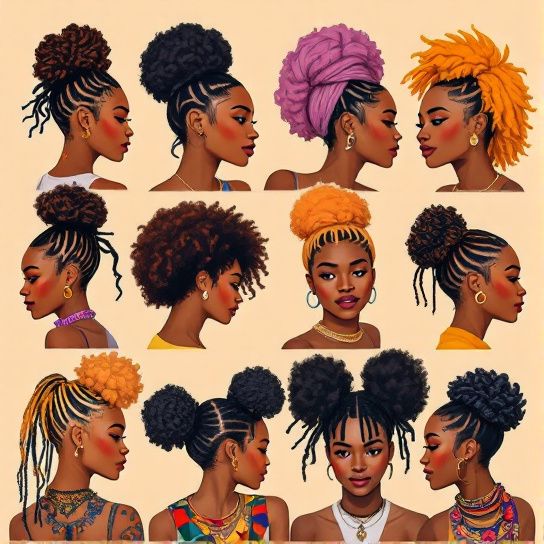
Hey there! So, I bet you’re here because you’ve heard the buzz about protective styling and its magic touch on hair health. Maybe, like many of us, you’re on a mission to figure out how to nurture your strands while trying to make them look fabulous. Well, you’re in the right place. Protective styling is like the VIP treatment your hair deserves and, trust me, it’s a game-changer if you do it right. So, why not dive in and see how you can make the most of this hair care marvel?
What is Protective Styling, Anyway?
Alright, let’s start from the top. Protective styling encompasses styles that shield your hair from the harsh realities of daily wear and tear. Think twists, braids, buns, or pretty much any style that tucks in your ends and reduces manipulation. The goal? Healthy, thriving hair that won’t break the moment you look at it wrong.
Protective styling helps your hair conserve moisture and avoid damage from over-exposure to elements like wind, sun, or even the wear and tear from repeated styling. Keeping all this in mind, it’s like putting your hair in a cozy blanket and letting it recharge while you flaunt your style.
Why Protective Styling is a Game-Changer for Hair Growth
Now, let’s talk about the growth miracle part. When done correctly, protective styling can actually bolster your quest for longer, healthier hair. Here’s the scoop: By significantly cutting down on friction and the need for constant combing or brushing, you’re giving your hair a chance to focus all its energy on growing strong and mighty.
Here’s an analogy. Imagine your hair as a tiny plant. If you’re constantly touching, uprooting, or messing with it, it loses confidence (and strength). But when left undisturbed in the right conditions, voila—it blooms! So, if you’re aiming for hair growth, protective styling is your new best bud.
How to Prep Your Hair for Protective Styling
Before jumping into a protective style, setting a solid groundwork is crucial. Preparation makes all the difference between a successful protective style that benefits your hair and one that could unintentionally lead to damage. Here’s a simple breakdown:
Clean It Up
First up, clean hair and scalp. Start with a gentle shampoo to remove all the dirt and product buildup. You’d be surprised what can sneakily accumulate over time. Clean hair ensures that any style you choose adheres well and lasts long without itchiness or irritation.
Moisturize Like Your Life Depends On It

Next, lock in that moisture. Use a good conditioner or a leave-in treatment to hydrate your locks. Adding in a deep-conditioning session wouldn’t hurt either. You want your hair nice and supple; that way, it’s not crying for help halfway through the styling.
Detangle Gently
Detangle, detangle, detangle. Using a wide-tooth comb or your fingers (yeah, patience is key) helps remove knots without breaking your hair. Think of it as giving your hair a love tap before moving into the big style change.
Choosing the Right Protective Style for Your Hair Type
Okay, so now you’re all prepped. But which style should you go for? It’s not as simple as one-size-fits-all. Different hair types and lifestyles might require diverse styles. Here’s a little guide based on what suits different hair types and growth ambitions.
For Naturally Curly or Coily Hair
Styles like twists, cornrows, or even faux locs can work wonders. They keep your ends hidden and safe—no need for heat styling and minimal manipulation. Plus, they look pretty cool!
For Straight to Wavy Hair
Consider braid styles or sleek low buns—it’s like tucking your hair in for a cozy nap. Anything that can protect the ends from friction and tangling without too much tension on the scalp is a good pick.
Lifestyle Considerations
Remember, choose a style that fits your daily routine. If you hit the gym regularly, something that stands the rough-and-tumble of workouts is ideal. Or perhaps you need something quick you can dress up or down for work or social events.
The Do’s and Don’ts of Protective Styling
Alright, let’s break this down into what’s beneficial and what’s better to skip over. This is where you get to avoid the common pitfalls.
Do’s
- Do Moisturize Regularly: Even though it’s protective, your hair can still crave attention now and then. A light, water-based moisturizing mist or leave-in conditioner is perfect.
- Do Mind the Scalp: Keep your scalp clean and hydrated. Natural oils like jojoba or coconut oil are fantastic as they mimic your scalp’s natural oils.
- Do Choose Gentle Hold: Styles that have a firm hold but aren’t pulling at your scalp allow your hair to rest and grow without stress.
Don’ts

- Don’t Keep Styles Indefinitely: It can be tempting to leave that fab style in forever, but two to eight weeks is about the sweet spot. Beyond that and your hair might start feeling neglected.
- Don’t Make It Too Tight: Tight styles can lead to traction alopecia, which is hair loss due to tension. Ouch, not fun.
- Don’t Skip Regular Care: Just because your hair is styled doesn’t mean it’s on vacation. Regularly check for tension or itchiness, and listen to what your hair needs.
Debunking Common Protective Styling Myths
Alright, card on the table—there’s a lot of misinformation out there about protective styling. Let’s clear that air a bit.
Myth 1: Protective styles don’t need any maintenance.
Far from it. Although low-maintenance, protective styles do require a regular touch of TLC. Checking tensions, moisturizing, and occasionally resting the hair are still essential steps.
Myth 2: All protective styles equally promote hair growth.
Nope. Here’s where the knowing-your-hair-type part comes in handy. Not every style suits every hair type or growth goal. Some might work better with certain textures while causing others stress and breakage.
Myth 3: You can keep the same protective style indefinitely.
Wishful thinking, right? Hair grows and changes underneath these styles. Limit how long you hold onto each style, giving your hair periodic rest in between.
Listening to Your Hair: Key Signs Your Protective Style Needs a Change

It’s okay if your protective style works right until suddenly it doesn’t. Your hair communicates what it needs—here are some signs it’s maybe time to switch things up.
- Dry Scalp and Itchiness: Could mean it’s not getting what it needs, or dirt and oils need to be cleaned out.
- Hair Breakage or Short Pieces: Time to rethink the style’s tension or your maintenance routine.
- Dull Appearance: It indicates it’s not absorbing enough moisture or that it’s weighed down by product build-up.
How to Make Your Protective Style Last (Without Neglecting Your Locks)
It’s the best of both worlds—having a long-lasting style while keeping your hair in top shape. Here’s how to manage the balancing act.
- Sleep Protection: Use satin or silk pillowcases and scarves to minimize tangling and friction. Your hair will thank you!
- Leave Product Build-Up at the Door: Too many products can weigh your hair down and even contribute to itching and scalp issues. Use lightweight products and avoid heavy, greasy concoctions.
- Regular Check-In: Every few days, take stock of your hair’s texture and situation. A small tweak here and there can preempt significant issues down the line.
Getting Back to Natural: Caring for Your Hair Post-Protection
When it’s time to take it all down, gently is your new keyword. Post-style is the time to focus on nurturing and assessing any potential stress points.
- Detangle with Patience: After removing your style, your hair is probably as tangled as you are before your first cup of coffee. Going slow minimizes breakage.
- Deep Repair Treatment: Here’s where a good deep-conditioning or protein treatment can refine texture and provide necessary replenishments to hair struggling with any stress or strain.
- Minimal Heat: Your hair has been through a lot—save heat styling for down the road to avoid undue stress.
In the end, truly keeping in tune with your hair needs and respecting the cues it gives you paves the golden path of protective styling success. Let your hair breathe, and don’t sweat the need for periodic changes and restructuring—it’s all part of the process. Remember, the best style that’s ever out there, even with all the protective styling options available, is always one that captures your vibe while keeping your hair happy and healthy.
Stay chic, stay protected, and have fun on this captivating hair health journey! Your crown deserves only the best.
Frequently Asked Questions
What is protective styling?
Protective styling refers to hairstyles that tuck the ends of the hair away and minimize manipulation, protecting the hair from environmental aggressors, daily wear and tear, and styling stress. Examples include braids, wigs, locks, twists, and buns[1][3][5).
Why is protective styling important for hair health?
Protective styling is crucial for hair health as it reduces the risk of breakage, knotting, and snagging. It protects the hair from harsh weather conditions, minimizes the need for daily styling, and helps in retaining hair length and promoting hair growth[1][3][5).
What are some common types of protective styles?
What are the potential risks associated with protective styling?
Despite the benefits, protective styling can pose risks such as product buildup, trapped shed hair, and tension alopecia if the styles are too tight or left in for too long. Proper maintenance, including regular washing and moisturizing, is essential to mitigate these risks[3][5).
References


Leave a Reply